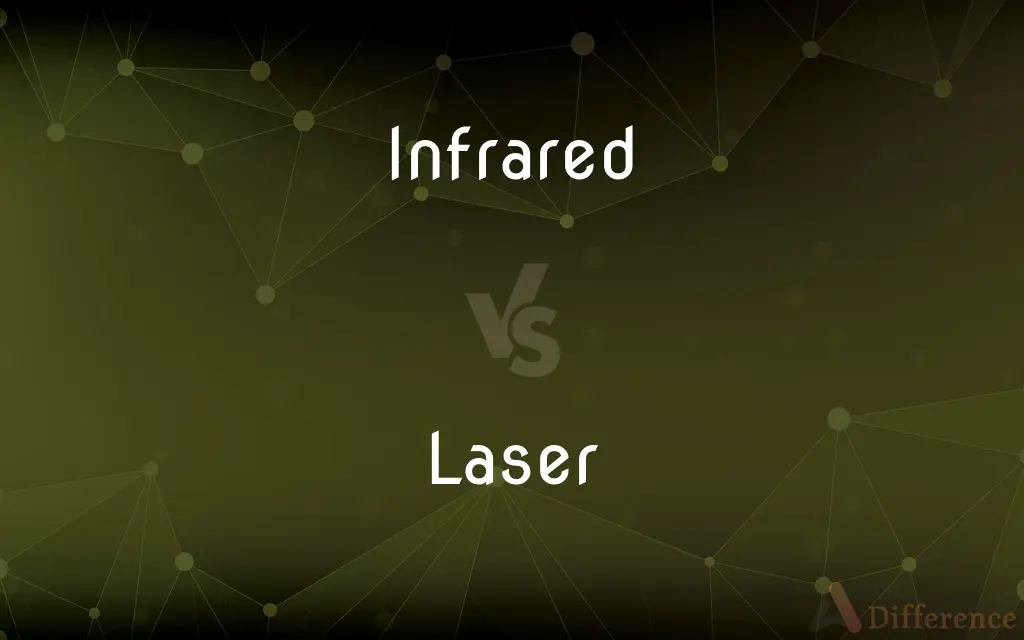Infrared vs. Laser — What's the Difference?
By Fiza Rafique & Urooj Arif — Updated on March 5, 2024
Infrared involves electromagnetic radiation with wavelengths longer than visible light, while lasers emit focused, coherent light beams, often in the visible spectrum.

Difference Between Infrared and Laser
Table of Contents
ADVERTISEMENT
Key Differences
Infrared technology is based on electromagnetic radiation with wavelengths longer than visible light but shorter than microwaves. It is commonly used in various applications, including remote controls, night vision equipment, and thermal imaging. On the other hand, laser technology produces a narrow, focused beam of light that is coherent and monochromatic, meaning the light waves are in phase and of a single color or wavelength.
Infrared operates in a specific part of the electromagnetic spectrum and is invisible to the human eye, making it ideal for applications that require non-visible light. Lasers can be designed to operate in various parts of the electromagnetic spectrum, including visible, ultraviolet, and infrared. They are used in a wide range of applications, from medical procedures and laser printing to cutting materials and optical communications.
Infrared light is typically used for its ability to transmit information or detect heat without being visible, making it suitable for security applications, wireless communication, and thermal imaging. Its use in devices like remote controls and night vision goggles takes advantage of infrared light's properties to operate effectively in darkness or through obstacles.
Lasers, with their focused and coherent beams, are valued for their precision and intensity. This makes them ideal for applications requiring high levels of accuracy, such as surgical procedures, the cutting and engraving of materials, and the scanning of barcodes. Lasers can be precisely controlled in terms of direction, intensity, and duration, allowing for their use in a variety of scientific, industrial, and medical applications.
While infrared technology primarily relies on the emission and detection of infrared radiation for communication or imaging, lasers utilize the stimulated emission of electromagnetic radiation to produce highly directed light beams. This fundamental difference in operation and application highlights the diverse capabilities of each technology.
ADVERTISEMENT
Comparison Chart
Nature
Electromagnetic radiation with longer wavelengths
Coherent, monochromatic light beam
Applications
Remote controls, night vision, thermal imaging
Surgery, cutting materials, communication
Visibility
Invisible to human eyes
Can be visible or invisible, depending on wavelength
Operation
Emission and detection of radiation
Stimulated emission of radiation
Key Characteristics
Used for heat detection and wireless communication
Precision, intensity, and controlled beam direction
Compare with Definitions
Infrared
Common in night vision equipment and thermal imaging.
Infrared cameras detect heat signatures, useful for security and surveillance.
Laser
Extensively used in medical procedures, manufacturing, and communication.
Lasers perform precise cuts in surgery and material fabrication.
Infrared
Electromagnetic radiation with wavelengths longer than visible light.
Infrared technology is used in remote controls to wirelessly communicate with TVs.
Laser
Produces coherent, focused light beams that can be highly controlled.
Laser engraving machines utilize focused light beams to etch designs onto surfaces.
Infrared
Invisible to the human eye and can penetrate through some obstacles.
Infrared signals from a remote control can pass through thin barriers to change TV channels.
Laser
Ideal for tasks requiring precision, such as cutting, engraving, and surgical procedures.
Ophthalmologists use lasers for corrective eye surgeries with high precision.
Infrared
Primarily for wireless communication and heat detection.
Infrared sensors are employed in home heating systems to monitor and adjust temperatures.
Laser
A device that emits light through a process of optical amplification based on the stimulated emission of electromagnetic radiation.
Laser pointers are used in presentations to highlight specific points on a screen.
Infrared
Offers non-visible, non-intrusive means of data transmission and heat sensing.
Infrared thermography is utilized for inspecting electrical systems without direct contact.
Laser
High accuracy, intensity, and the ability to focus on small areas.
Lasers are crucial in fiber optic cables, enabling fast and efficient data transmission.
Infrared
Infrared (IR), sometimes called infrared light, is electromagnetic radiation (EMR) with wavelengths longer than those of visible light. It is therefore invisible to the human eye.
Laser
A laser is a device that emits light through a process of optical amplification based on the stimulated emission of electromagnetic radiation. The word "laser" is an acronym for "light amplification by stimulated emission of radiation".
Infrared
Of or relating to electromagnetic radiation between microwaves and red visible light in the electromagnetic spectrum, having frequencies between 300 gigahertz and 400 terahertz and wavelengths between 1 millimeter and 750 nanometers.
Laser
Any of several devices that emit highly amplified and coherent radiation of one or more discrete wavelengths. One of the most common lasers makes use of atoms in a metastable energy state, which, as they decay to a lower energy level, stimulate others to decay, resulting in a cascade of emitted radiation.
Infrared
Generating, using, or sensitive to infrared radiation.
Laser
A beam of radiation emitted by a laser.
Infrared
Infrared light or the infrared part of the spectrum.
Laser
A device that produces a monochromatic, coherent beam of light.
Infrared
(uncountable) The electromagnetic radiation of a wavelength longer than visible light, but shorter than microwave radiation, having a wavelength between 700 nm and 1 mm.
Electromagnetic radiation
Laser
A beam of light produced by such a device; a laser beam.
Infrared
The infrared part of the electromagnetic spectrum; electromagnetic wave frequencies below the visible range;
They could sense radiation in the infrared
Laser
A device which produces an intense, usually narrow, monochromatic beam of coherent light; called also optical maser. It has various forms, and is used in various applications in science and technology. The beam is produced by boosting the majority of the electrons in specific radiation-absorbing atoms in a medium into a higher energy level, from which they are stimulated by their own emitted radiation to drop back synchronously to their lower energy level, and emit light which is in phase (coherent).
Infrared
Electromagnetic radiation with wavelengths longer than visible light but shorter than radio waves
Laser
An acronym for light amplification by stimulated emission of radiation; an optical device that produces an intense monochromatic beam of coherent light
Infrared
Having or employing wavelengths longer than light but shorter than radio waves; lying outside the visible spectrum at its red end;
Infrared radiation
Infrared photography
Common Curiosities
What makes lasers suitable for surgical procedures?
Lasers offer high precision, control, and the ability to focus on very small areas, making them ideal for surgeries.
How do infrared cameras work?
Infrared cameras detect the infrared radiation (heat) emitted by objects and convert it into an image.
Can lasers emit infrared light?
Yes, lasers can be designed to emit in various parts of the spectrum, including infrared.
Are infrared applications visible to the human eye?
No, infrared radiation is invisible to the human eye but can be detected by specialized equipment.
Is it safe to use infrared technology in consumer products?
Yes, when used within regulatory standards, infrared technology is safe for consumer products like remote controls.
How do lasers contribute to manufacturing processes?
Lasers are used in cutting, welding, and engraving materials with high precision and efficiency.
Can infrared technology be used for medical applications?
Yes, infrared technology is used in medical diagnostics, such as thermal imaging for detecting inflammation.
What are the safety concerns with laser use?
Improper use of lasers, especially high-power lasers, can pose risks like eye injury, necessitating safety precautions.
What distinguishes infrared from laser technology?
Infrared operates with longer wavelengths for heat detection and wireless communication, while lasers emit focused and coherent light beams for precision applications.
Can infrared be used for internet connectivity?
Yes, infrared technology can facilitate short-range, line-of-sight wireless internet connections.
What are the advantages of using laser technology in communication?
Lasers enable high-speed, efficient, and precise data transmission, especially in optical fiber communication.
How do night vision goggles utilize infrared?
Night vision goggles amplify available light, including infrared radiation, to make environments visible in darkness.
Why are lasers preferred for barcode scanning?
Lasers provide accuracy and speed in scanning barcodes, even at a distance or on uneven surfaces.
What role does laser technology play in the field of communications?
Lasers are pivotal in fiber optic communications, offering fast and secure data transmission over long distances.
How does the use of infrared technology in home heating systems work?
Infrared heaters emit radiation that directly warms objects and people in a room, providing efficient heating.
Share Your Discovery

Previous Comparison
Idealist vs. Idealistic
Next Comparison
Eager vs. PassionateAuthor Spotlight
Written by
Fiza RafiqueFiza Rafique is a skilled content writer at AskDifference.com, where she meticulously refines and enhances written pieces. Drawing from her vast editorial expertise, Fiza ensures clarity, accuracy, and precision in every article. Passionate about language, she continually seeks to elevate the quality of content for readers worldwide.
Co-written by
Urooj ArifUrooj is a skilled content writer at Ask Difference, known for her exceptional ability to simplify complex topics into engaging and informative content. With a passion for research and a flair for clear, concise writing, she consistently delivers articles that resonate with our diverse audience.















































